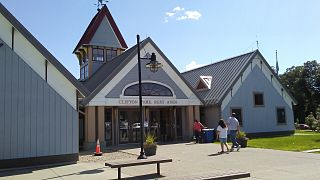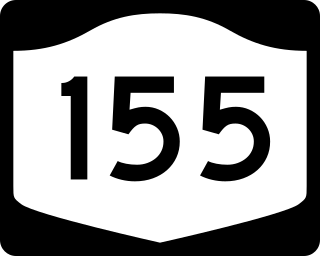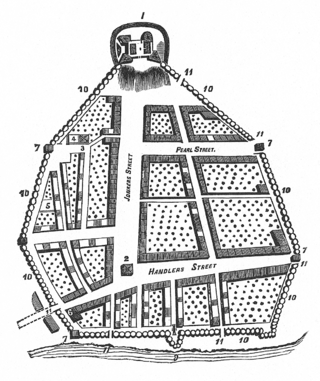
Clifton Park is a suburban town in Saratoga County, New York, United States. According to the United States Census Bureau, the 2020 population was 38,029. The name is derived from an early land patent. The town is in the southern part of Saratoga County, approximately 12 miles (19 km) north of Albany, 7 miles (11 km) northeast of Schenectady, and 10 miles (16 km) south of Saratoga Springs.

Glenville is a town in Schenectady County, New York, United States. It was incorporated in 1821 from Schenectady. As of the 2020 census, the town population was 29,326.

Colonie is a town in Albany County, New York, United States. It is the most-populous suburb of Albany, and is the third-largest town in area in Albany County, occupying approximately 11% of the county. Several hamlets exist within the town. As of the 2020 census, the town had a total population of 85,590.

Niskayuna is a town in Schenectady County, New York, United States. The population was 23,278 at the 2020 census. The town is located in the southeast part of the county, east of the city of Schenectady, and is the easternmost town in the county.

The Capital District, also known as the Capital Region and the endonym Capitaland, is the metropolitan area surrounding Albany, the capital of the U.S. state of New York. The Capital District was first settled by the Dutch in the early 17th century and came under English control in 1664. Albany has been the permanent capital of the state of New York since 1797. The Capital District is notable for many historical events that predate the independence of the United States, including the Albany Plan of Union and the Battles of Saratoga.

New York State Route 2 (NY 2) is a state highway in the Capital District of New York in the United States. It extends for 30.89 miles (49.71 km) from an interchange with Interstate 87 (I-87) and NY 7 in the town of Colonie to the Massachusetts state line in Petersburgh, where it continues to Boston as Massachusetts Route 2. The route passes through the cities of Watervliet and Troy, where it connects to NY 32 and U.S. Route 4, respectively. In Grafton, located midway between Troy and Massachusetts, NY 2 serves Grafton Lakes State Park.

New York State Route 7 (NY 7) is a 180.30-mile-long (290.16 km) state highway in New York in the United States. The highway runs from Pennsylvania Route 29 (PA 29) at the Pennsylvania state line south of Binghamton in Broome County, New York, to Vermont Route 9 (VT 9) at the Vermont state line east of Hoosick in Rensselaer County. Most of the road runs along the Susquehanna Valley, closely paralleling Interstate 88 (I-88) throughout that road's length. Portions of the highway route near the cities of Binghamton, Schenectady, and Troy date back to the early 19th century.

The Capital District Transportation Authority (CDTA) is a New York State public-benefit corporation overseeing a number of multi-modal parts of public transportation in the Capital District of New York State. CDTA runs local and express buses, including three lines of an express bus service called BusPlus, and day-to-day management of three Amtrak stations in the Capital region–the Albany-Rensselaer, Schenectady and Saratoga Springs Amtrak stations. In 2022, the system had a ridership of 13,109,300, or about 48,600 per weekday as of the second quarter of 2023.

Loudonville is a hamlet in the town of Colonie, in Albany County, New York, United States. Loudonville was a census-designated place in the 1970, 1980, and 1990 US Census, but ceased to be in the 2000 Census, but became a CDP again in 2020.

New York State Route 9R (NY 9R) is a north–south state highway in northeastern Albany County, New York, in the United States. The route is a 3.22-mile (5.18 km) eastern loop of U.S. Route 9 (US 9), connecting that route to the city of Cohoes 1.5 miles (2.4 km) to the east. It leaves US 9 in the hamlet of Latham and rejoins its parent in the hamlet of Boght Corners, both located in the town of Colonie. Most of NY 9R is a two-lane highway that passes through residential areas; however, the southwesternmost portion of the route is four lanes wide and serves a commercial district. The route was assigned c. 1939 and has remained largely unchanged since that time, save for a brief period during the 1970s where NY 9R was partially replaced by NY 470.
Boght Corners is a hamlet in the town of Colonie in northern Albany County, New York, United States, that straddles U.S. Route 9. The corners that give the hamlet its name are found at the intersection of Route 9 and Boght Road, near the Boght Community Fire District's station. The community is served by the North Colonie Central School District. Boght Hills Elementary School is located within the hamlet.

New York State Route 155 (NY 155) is a 16.85-mile-long (27.12 km) state highway located entirely within Albany County in the Capital District of New York. The western terminus of the route is at NY 85A in Voorheesville. The eastern terminus is at NY 32 in Watervliet. NY 155 mainly serves as a connection to the Albany International Airport from the major roads it connects to.
Crescent Station is a hamlet of the town of Colonie in Albany County, New York, United States that straddles US Route 9.
Dunsbach Ferry is a hamlet of the town of Colonie, in Albany County, New York, United States. The hamlet sits to the east of, and below, the Thaddeus Kosciusko Bridge, where Interstate 87 (I-87) crosses the Mohawk River. There are numerous private and public docks and landings between the Twin Bridges and the Colonie Town Park. Dunsbach Ferry was once an important river crossing and a stop on the Schenectady and Troy Railroad (T&S), later a branch of the New York Central Railroad. The ZIP code is 12047 (Cohoes).
Verdoy, formerly known as Watervliet Center, is a hamlet of the town of Colonie in Albany County, New York, United States. Much of Verdoy is in the Airport Noise Overlay District due to its immediate proximity to Albany International Airport's main north/south runway, which was recently extended by 1,300 feet to the north, moving it even closer to Verdoy. The former Troy & Schenectady Branch of the New York Central Railroad runs along Verdoy's northern border with the Mohawk River; it is now part of the Mohawk Hudson Hike/Bike Trail.
Central Avenue, in Albany, New York, is an 18 km stretch in Albany County, of the 26 km Albany-Schenectady Turnpike, which runs from Lark Street in the city of Albany, westward through the towns of Colonie, New York and Niskayuna, New York, to the city of Schenectady, New York. In the city of Albany it is called Central Avenue, in Colonie it is known as Central Avenue or Albany Schenectady Road, and in Schenectady County it is called State Street. The entire route is also called Route 5.

The Latham Circle is the intersection of U.S. Route 9 (US 9) and New York State Route 2 (NY 2) within the town of Colonie, New York in Albany County.
Newtonville is a hamlet in the town of Colonie in Albany County, New York, United States. Located along U.S. Route 9, the hamlet is just south of Latham and north of Loudonville. Colonie Town Hall is located in the hamlet of Newtonville.
Mohawk Mall was an enclosed shopping mall in the town of Niskayuna, New York, on a 50-acre (200,000 m2) parcel located at the corner of State Street and Balltown Road. It was managed by Genesee Management. It had three courts with groups of fountains and seating areas. The mall was first opened in 1970 and mostly demolished in 2000, with its last remaining section demolished in 2002. The property has been redeveloped into Mohawk Commons, a lifestyle center.

The streets of Albany, New York have had a long history going back almost 400 years. Many of the streets have changed names over the course of time, some have changed names many times. Some streets no longer exist, others have changed course. Some roads existed only on paper. The oldest streets were haphazardly laid out with no overall plan until Simeon De Witt's 1794 street grid plan. The plan had two grids, one west of Eagle Street and the old stockade, and another for the Pastures District south of the old stockade.















